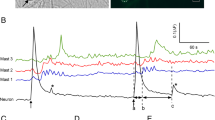Abstract
The intracellular pH of rat peritoneal mast cells was slightly acidic and compound 48/80 induced a decrease in the cytoplasmic pH of these cells. By means of chemical skinning, it was revealed that perfusion with Ca2+ or inositol 1,4,5-trisphosphate (IP3) induced degranulation dose-dependently in mast cells at concentrations higher than 10 μM and 0.1 μM, respectively. Na+ was essential for the release of histamine from mast cells. An assay based on the binding of45Ca to mast cell fragments revealed that the intracellular Ca store of the mast cell is located in the endoplasmic reticulum. IP3 liberated Ca from the endoplasmic reticulum.
Similar content being viewed by others
References
K. Tasaka, M. Mio and M. Okamoto,Changes in intracellular Ca 2+ distribution of rat peritoneal mast cells before and after histamine release. Agents and Actions18, 61–64 (1986).
K. Tasaka, M. Mio and M. Okamoto,Intracellular calcium release induced by histamine releasers and its inhibition by some antiallergic drugs. Annals Allergy54, 464–469 (1986).
S. K. Joseph, A. P. Thomas, R. J. Williams, R. F. Irvine and J. R. Williamson,myo-Inositol 1,4,5-trisphosphate. A second messenger for the hormonal mobilization of intracellular Ca 2+ in liver. J. biol. Chem.259, 3077–3081 (1984).
M. Mio, A. Ikeda, M. Akagi and K. Tasaka,Inhibitory effect of lysophosphatidylcholine on the histamine release from rat mast cells. Agents and Actions16, 113–117 (1985).
T. J. Rink, R. Y. Tsien and T. Pozzan,Cytoplasmic pH and free Mg in lymphocytes. J. Cell Biol.95, 189–196 (1982).
H. A. Pershadsingh and J. M. McDonald,A high affinity calcium-stimulated magnesium-dependent adenosine triphosphatase in rat adipocyte plasma membranes. J. biol. Chem.255, 4087–4093 (1980).
W. K. Miskimins and N. Shimizu,Dual pathways for epidermal growth factor processing after receptor-mediated endocytosis. J. Cell Physiol.112, 327–338 (1982).
H. Beaufay, A. Amar-Costesec, E. Feytmans, D. Thines-Sempoux, M. Wibo, M. Robbi and J. Berthet,Analytical study of microsomes and isolated subcellular membranes from rat liver. I. Biochemical methods. J. Cell Biol.61, 188–200 (1974).
B. Uvnäs,Cation-induced histamine release from a synthetic weak (carboxylic) cation exchanger resin (IRC-50) and from isolated mast cell granules show identical kinetics. Agents and Actions16, 129–132 (1985).
C.-H. Åborg and B. Uvnäs,Mode of binding of histamine and some other biogenic amines to a protamine-heparin complex in vitro. Acta physiol. scand.74, 552–567 (1968).
Author information
Authors and Affiliations
Rights and permissions
About this article
Cite this article
Tasaka, K., Mio, M. & Okamoto, M. The role of intracellular Ca2+ in the degranulation of skinned mast cells. Agents and Actions 20, 157–160 (1987). https://doi.org/10.1007/BF02074656
Issue Date:
DOI: https://doi.org/10.1007/BF02074656




